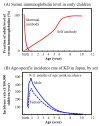Hygiene Hypothesis as the Etiology of Kawasaki Disease: Dysregulation of Early B Cell Development
- PMID: 34830213
- PMCID: PMC8622879
- DOI: 10.3390/ijms222212334
Hygiene Hypothesis as the Etiology of Kawasaki Disease: Dysregulation of Early B Cell Development
Abstract
Kawasaki disease (KD) is an acute systemic vasculitis that occurs predominantly in children under 5 years of age. Despite much study, the etiology of KD remains unknown. However, epidemiological and immunological data support the hygiene hypothesis as a possible etiology. It is thought that more sterile or clean modern living environments due to increased use of sanitizing agents, antibiotics, and formula feeding result in a lack of immunological challenges, leading to defective or dysregulated B cell development, accompanied by low IgG and high IgE levels. A lack of B cell immunity may increase sensitivity to unknown environmental triggers that are nonpathogenic in healthy individuals. Genetic studies of KD show that all of the KD susceptibility genes identified by genome-wide association studies are involved in B cell development and function, particularly in early B cell development (from the pro-B to pre-B cell stage). The fact that intravenous immunoglobulin is an effective therapy for KD supports this hypothesis. In this review, I discuss clinical, epidemiological, immunological, and genetic studies showing that the etiopathogenesis of KD in infants and toddlers can be explained by the hygiene hypothesis, and particularly by defects or dysregulation during early B cell development.
Keywords: B cells; Kawasaki disease; hygiene hypothesis; intravenous immunoglobulin.
Conflict of interest statement
The author declares no conflict of interest.
Figures





Similar articles
-
The mechanism underlying B-cell developmental dysfunction in Kawasaki disease based on single-cell transcriptomic sequencing.Front Immunol. 2024 Oct 23;15:1438640. doi: 10.3389/fimmu.2024.1438640. eCollection 2024. Front Immunol. 2024. PMID: 39507528 Free PMC article.
-
Adjuvant herbal therapy for targeting susceptibility genes to Kawasaki disease: An overview of epidemiology, pathogenesis, diagnosis and pharmacological treatment of Kawasaki disease.Phytomedicine. 2020 Apr 15;70:153208. doi: 10.1016/j.phymed.2020.153208. Epub 2020 Mar 18. Phytomedicine. 2020. PMID: 32283413 Free PMC article. Review.
-
Single-cell RNA sequencing of peripheral blood mononuclear cells from acute Kawasaki disease patients.Nat Commun. 2021 Sep 14;12(1):5444. doi: 10.1038/s41467-021-25771-5. Nat Commun. 2021. PMID: 34521850 Free PMC article.
-
Increased frequency of immunoglobulin (Ig)A-secreting cells following Toll-like receptor (TLR)-9 engagement in patients with Kawasaki disease.Clin Exp Immunol. 2011 Mar;163(3):346-53. doi: 10.1111/j.1365-2249.2010.04297.x. Epub 2010 Dec 22. Clin Exp Immunol. 2011. PMID: 21175593 Free PMC article.
-
Intravenous immunoglobulin, pharmacogenomics, and Kawasaki disease.J Microbiol Immunol Infect. 2016 Feb;49(1):1-7. doi: 10.1016/j.jmii.2014.11.001. Epub 2014 Nov 11. J Microbiol Immunol Infect. 2016. PMID: 25556045 Review.
Cited by
-
Unexpectedly high incidence of Kawasaki Disease in a Canadian Atlantic Province- an 11-year retrospective descriptive study.Pediatr Rheumatol Online J. 2023 Apr 3;21(1):30. doi: 10.1186/s12969-023-00805-y. Pediatr Rheumatol Online J. 2023. PMID: 37013572 Free PMC article.
-
The mechanism underlying B-cell developmental dysfunction in Kawasaki disease based on single-cell transcriptomic sequencing.Front Immunol. 2024 Oct 23;15:1438640. doi: 10.3389/fimmu.2024.1438640. eCollection 2024. Front Immunol. 2024. PMID: 39507528 Free PMC article.
-
Concurrent infections in children with Kawasaki disease: lessons learned over 26 years.Immunol Res. 2025 Feb 26;73(1):56. doi: 10.1007/s12026-025-09607-8. Immunol Res. 2025. PMID: 40009125
-
Kawasaki Disease and Coronary Artery Involvement: A Narrative Review.Cureus. 2022 Aug 24;14(8):e28358. doi: 10.7759/cureus.28358. eCollection 2022 Aug. Cureus. 2022. PMID: 36185934 Free PMC article. Review.
-
Single cell sequencing technology reveals the correlation between B lymphocytes and vascular inflammatory symptoms of Kawasaki disease.Transl Pediatr. 2025 Apr 30;14(4):582-596. doi: 10.21037/tp-2025-19. Epub 2025 Apr 27. Transl Pediatr. 2025. PMID: 40386362 Free PMC article.
References
-
- Kawasaki T. Acute febrile mucocutaneous syndrome with lymphoid involvement with specific desquamation of the fingers and toes in children. Arerugi. 1967;16:178–222. Note: An English translation was published in Pediat. Infect. Dis. J. 2002, 21, 1–38. - PubMed
-
- Durongpisitkul K., Gururaj V.J., Park J.M., Martin C.F. The prevention of coronary artery aneurysm in Kawasaki disease: A meta-analysis on the efficacy of aspirin and immunoglobulin treatment. Pediatrics. 1995;96:1057–1061. - PubMed
Publication types
MeSH terms
Substances
Grants and funding
LinkOut - more resources
Full Text Sources
Medical

